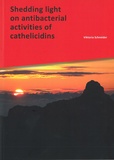Shedding light on antibacterial activities of cathelicidins

Schneider, Viktoria
- Promoter:
- Prof.dr. H.P. (Henk) Haagsman
- Co-promoter:
- Dr. E.J.A. (Edwin) Veldhuizen
- Research group:
- Haagsman
- Date:
- May 26, 2016
- Time:
- 12:45 h
Summary
Antibiotic resistance is continuously increasing and has a tremendous impact on human and animal well-being. Attractive alternatives to conventional antibiotics are host defense peptides (HDP), such as chicken cathelicidin-2 (CATH-2) and porcine proline-rich PR-39. HDPs are small cationic molecules and key players of the innate defense system. HDPs have a broad-range antibacterial activity against Gram-negative and Gram-positive bacteria. Furthermore, HDPs are able to boost the innate immune system and possess immunomodulatory properties by i.e. causing chemotaxis, endotoxin inhibition, cell differentiation and triggering cytokine production.
The aim of this thesis was to deepen our knowledge on the antibacterial mode of action of CATH-2 and obtain first insights on the (possibly) immunomodulatory effects of this peptide in vivo. In addition, PR-39 and its truncated versions were tested for their antibacterial and immunomodulatory activities.
The antibacterial mode of action of CATH-2 was tested against Escherichia coli and methicillin-resistant Staphylococcus aureus (MRSA), based on a variety of different microscopic and biochemical methods. The membrane was shown to be an important target of the peptide, as the peptide caused binding and permeabilization. Transmission electron microscopy demonstrated that CATH-2 induces dose-dependent morphological changes. Interestingly, sub-minimal inhibitory concentrations (sub-MIC) of the peptide resulted in intracellular changes (relocalization of DNA and ribosomes), whereas MIC values had detrimental effects on the bacterial membranes. Immunogold labelling of these electron microscopy sections demonstrated that at low concentrations CATH-2 already translocated intracellularly without visible membrane permeabilization. Additional time killing studies demonstrated that most effects occurred already within the first minutes after incubation, highlighting the rapid actions of the peptide.
CATH-2 is known to have immunomodulatory properties in vitro (LPS inhibition, DNA uptake in endosomes of macrophages). Our zebrafish studies demonstrated that CATH-2 yolk-injection of 0.2 to 1.5 hour post-fertilized (hpf) embryos resulted in a 30 % increase of phagocytic cells. A novel approach was developed combining peptide pre-injection in 0.2 to 1.5 hpf embryos and additionally challenge the same embryos at 28 hpf with Salmonella. This prophylactic treatment showed that low CATH-2 concentrations cause partial protection in zebrafish embryos by boosting the innate immune system.
PR-39 is a known antibacterial and immunomodulatory peptide. Our study focused on PR-39 truncations in order to seek for core elements of the peptide, which are important for their biological function. The N-terminal truncations demonstrated to have similar antibacterial activity compared to the full-length peptide; however, in the presence of salt these peptides lost their activity. With respect to the immunomodulatory properties only the mature PR-39 peptide induced IL-8 and TNF-α production.
The work in this thesis presents unique approaches to study the mechanism of action of host defense peptides. The methods used in these studies can be a new starting point in unravelling the biological features of (antimicrobial) HDPs. The exact antibacterial mode of action and immunomodulatory functions for CATH-2 and PR-39 have not been revealed yet; however, the obtained results advance our understanding and are essential to develop anti-infectives based on HDPs.